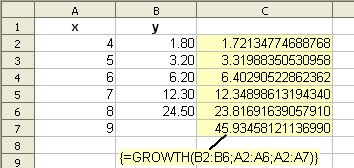Difference between revisions of "Documentation/How Tos/Calc: GROWTH function"
From Apache OpenOffice Wiki
< Documentation | How Tos
OOoWikiBot (Talk | contribs) m (Robot: Automated text replacement %s) |
|||
| (8 intermediate revisions by 3 users not shown) | |||
| Line 1: | Line 1: | ||
| − | + | {{Documentation/MasterTOC | |
| + | |bookid=1234''' | ||
| + | |booktitle=<div style="padding: 8px; font-size: 140%; font-weight: bold; background-color: #9BC0F5;">CALC FUNCTIONS</div> | ||
| + | |ShowParttitle=block | ||
| + | |parttitle=[[Documentation/How_Tos/Calc:_Array_functions|<div style="font-size: 140%;">Arrays Functions]] | ||
| + | |ShowNextPage=block | ||
| + | |NextPage= Documentation/How_Tos/Calc:_LINEST_function | ||
| + | |ShowPrevPage=block | ||
| + | |PrevPage= Documentation/How_Tos/Calc:_FREQUENCY_function | ||
| + | |ShowPrevPart=block | ||
| + | |PrevPart= Documentation/Reference/Calc_functions | ||
| + | |ShowNextPart=block | ||
| + | |NextPart= Documentation/How_Tos/Calc:_Complex_Number_functions | ||
| + | |toccontent= <div style="padding: 4px; font-size: 130%; font-weight: hidden; background-color:#DCE9FC;">FUNCTIONS</div> | ||
| + | |||
| + | * [[Documentation/How_Tos/Calc:_FREQUENCY_function|<div style="font-size: 120%;">Frequency]] | ||
| + | * [[Documentation/How_Tos/Calc:_GROWTH_function|<div style="font-size: 120%; | ||
| + | border-style: double; border-color:#778899;">Growth</div>]] | ||
| + | * [[Documentation/How_Tos/Calc:_LINEST_function|<div style="font-size: 120%;">Linest]] | ||
| + | * [[Documentation/How_Tos/Calc:_LOGEST_function|<div style="font-size: 120%;">Longest]] | ||
| + | * [[Documentation/How_Tos/Calc:_MDETERM_function|<div style="font-size: 120%;">Mdeterm]] | ||
| + | * [[Documentation/How_Tos/Calc:_MINVERSE_function|<div style="font-size: 120%;">Minverse]] | ||
| + | * [[Documentation/How_Tos/Calc:_MMULT_function|<div style="font-size: 120%;">Mmult]] | ||
| + | * [[Documentation/How_Tos/Calc:_MUNIT_function|<div style="font-size: 120%;">Munit]] | ||
| + | * [[Documentation/How_Tos/Calc:_SUMPRODUCT_function|<div style="font-size: 120%;">Sumproduct]] | ||
| + | * [[Documentation/How_Tos/Calc:_SUMX2MY2_function|<div style="font-size: 120%;">vSumx2my2]] | ||
| + | * [[Documentation/How_Tos/Calc:_SUMX2PY2_function|<div style="font-size: 120%;">Sumx2py2]] | ||
| + | * [[Documentation/How_Tos/Calc:_SUMXMY2_function|<div style="font-size: 120%;">Sumxmy2]] | ||
| + | * [[Documentation/How_Tos/Calc:_TRANSPOSE_function|<div style="font-size: 120%;">Transpose]] | ||
| + | * [[Documentation/How_Tos/Calc:_TREND_function|<div style="font-size: 120%;">Trend]] | ||
| + | }} | ||
| + | __TOC__ | ||
== GROWTH == | == GROWTH == | ||
| Line 23: | Line 54: | ||
<br style="clear:both;" /> | <br style="clear:both;" /> | ||
| − | {{ | + | {{SeeAlso|EN| |
| − | * [[Documentation/How_Tos/Calc: TREND function|TREND]] | + | * [[Documentation/How_Tos/Calc: TREND function|TREND]] |
* [[Documentation/How_Tos/Calc: LOGEST function|LOGEST]] | * [[Documentation/How_Tos/Calc: LOGEST function|LOGEST]] | ||
| Line 33: | Line 64: | ||
* [[Documentation/How_Tos/Calc: Functions listed alphabetically|Functions listed alphabetically]] | * [[Documentation/How_Tos/Calc: Functions listed alphabetically|Functions listed alphabetically]] | ||
* [[Documentation/How_Tos/Calc: Functions listed by category|Functions listed by category]]}} | * [[Documentation/How_Tos/Calc: Functions listed by category|Functions listed by category]]}} | ||
| + | [[Category: Documentation/Reference/Calc/Array functions]] | ||
| + | [[Category: Documentation/Reference/Calc/Statistical functions]] | ||
Revision as of 08:40, 17 July 2018
CALC FUNCTIONS
